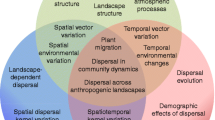Abstract
As part of a series of experiments on determining the risk of introducing genetically modified wind-pollinated forage grasses an experiment on pollen dispersal was conducted and the use of theoretical descriptions to predict dispersal in model systems investigated. Pollen traps were placed around a central source of Lolium perenne. Traps were exposed with their sticky surfaces towards and away from the pollen source and also facing skywards during four stages of anthesis (early, mid 1, mid 2 and late). There was a great deal of variation in dispersal over time and to traps of different orientations. Twelve datasets were collected and used to comprehensively test Bateman’s equations for the wind dispersal of pollen. The equations were not particularly useful for describing dispersal over distance and clearly need to be modified to take factors such as wind direction into account.
Similar content being viewed by others
Author information
Authors and Affiliations
Additional information
Received: 5 June 1996 / Accepted: 11 October 1996
Rights and permissions
About this article
Cite this article
Giddings, G., Hamilton, N. & Hayward, M. The release of genetically modified grasses. Part 1: pollen dispersal to traps in Lolium perenne. Theor Appl Genet 94, 1000–1006 (1997). https://doi.org/10.1007/s001220050507
Issue Date:
DOI: https://doi.org/10.1007/s001220050507




